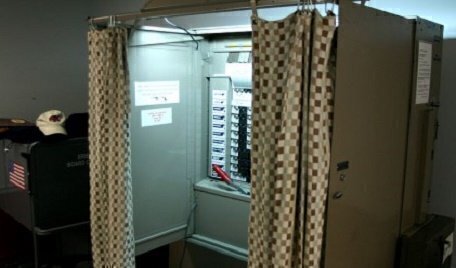On Monday, the Supreme Court accepted an appeal about the ability of a voter to wear clothing or campaign buttons at a polling place that endorses a political cause.
 The case of Minnesota Voters Alliance v. Mansky had been before the nine Justices in private conference on five occasions until it was granted a court date. The question under consideration is if a Minnesota law that “broadly bans all political apparel at the polling place, facially overbroad under the First Amendment.”
The case of Minnesota Voters Alliance v. Mansky had been before the nine Justices in private conference on five occasions until it was granted a court date. The question under consideration is if a Minnesota law that “broadly bans all political apparel at the polling place, facially overbroad under the First Amendment.”
The law, Minnesota Statute Section 211B.11, actually prevents voters from wearing political badges, political buttons, or other “political insignia” at polling places, because the messages communicated are “designed to influence and impact voting” or promote a “group with recognizable political views.”
The controversy started when Andrew Cilek of Hennepin County was temporarily stopped from voting because he was wearing a t-shirt with a “Don’t Tread on Me” and a Tea Party slogan, and a button endorsing Voter ID policies from a group called Election Integrity Watch.
The Minnesota law creates a “speech-free zone” in effect because it allows election officials to determine polices that ban political speech at the polls, Cilek and his supporters contend. When they first sued, a district court dismissed the case, in part citing a 1992 Supreme Court decision, Burson v. Freeman. In that 5-3 decision, Justice Harry Blackmun found that that the state of Tennessee had the right to establish a “restricted zone around polling places” as “necessary to serve the interest in protecting the right to vote freely and effectively.”
“The State, as recognized administrator of elections, has asserted that the exercise of free speech rights conflicts with another fundamental right, the right to cast a ballot in an election free from the taint of intimidation and fraud. A long history, a substantial consensus, and simple common sense show that some restricted zone around polling places is necessary to protect that fundamental right,” Blackmun concluded.
A divided Eighth Circuit appeals court upheld the lower court decision, relying on the Burson decision and three decisions from other federal circuit courts. One of the dissenting Eighth Circuit judges noted that that Burson precedent only applied to political messages “that endorsed either a candidate or a ballot issue in the election.”
In their appeal to the Supreme Court, the attorneys for the petitioners noted that two other federal appeals courts, the Fourth Circuit and the Seventh Circuit, found that a broad ban on political speech at the polls conflicts with the First Amendment. And they added that nine other states have broad bans on political clothing at polls that could be in conflict with the First Amendment.
The state of Minnesota had urged the Supreme Court to deny the appeal. “Minnesota law, like that of every other state, has long protected the sanctity of the polling place by creating a zone in which the only occurrence is voting related activity,” it claimed. The state law is “a reasonable and viewpoint-neutral restriction …inside the polling place,” the state concluded.
At least four of the nine Supreme Court Justices voted to take the case in private conference last week. Arguments will be heard next spring.
Scott Bomboy is the editor in chief of the National Constitution Center.







